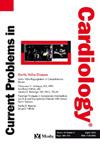Prognostic value of right ventricle–pulmonary artery uncoupling in elderly patients hospitalized for heart failure with preserved ejection fraction
IF 3.3
3区 医学
Q2 CARDIAC & CARDIOVASCULAR SYSTEMS
引用次数: 0
Abstract
Background
The TAPSE/PASP ratio reflects right ventricle–pulmonary artery (RV-PA) coupling and has prognostic value in patients with heart failure, regardless of left ventricular ejection fraction (LVEF). The objective of this study was to assess the prognostic impact of the TAPSE/PASP ratio in elderly patients hospitalized for acute heart failure with preserved ejection fraction (HFpEF).
Methods
Prospective, observational, and single-center cohort study included patients aged ≥75 years, hospitalized for HFpEF (LVEF >50 %) from September 2019 to December 2023. We excluded patients with significant left-sided valvular disease, advanced renal failure, recent myocardial infarction, and pacemaker users. We defined RV-PA uncoupling as a TAPSE/PASP ratio ≤0.40 using ROC analysis and the Youden index. The primary endpoint was a composite of all-cause mortality and HF rehospitalization at one year.
Results
We included a total of 142 patients. The median age was 84 [IQR 78-88] years, and 65 % (n = 92) were female. The mean LVEF was 56 % (±4 %), and 37 % (n = 53) had RV-PA uncoupling. Patients with uncoupling had higher NT-proBNP (5300 [3107-7257] vs. 2740 [1300-5857] pg/dL; p = 0.01) and troponin levels (48 [32-100] vs. 33 [19-61] pg/dL; p = 0.02), along with worse RV function compared to patients without RV-PA uncoupling. The primary endpoint occurred more frequently in patients with RV/PA uncoupling (62 % vs. 33 %; p = 0.001). In the Cox multivariate analysis, RV-PA uncoupling was independently associated with the primary endpoint (HR 2.37; 95 % CI 1.38–4.07; p = 0.02), after adjusting for age and NT-proBNP levels.
Conclusion
In elderly patients hospitalized for HFpEF, RV-PA uncoupling, defined by a TAPSE/PASP ratio ≤ 0.40 was significantly associated with worse outcomes during one-year follow-up.
右心室-肺动脉解耦在保留射血分数的老年心力衰竭住院患者中的预后价值
背景:TAPSE/PASP比值反映了右心室-肺动脉(RV-PA)耦合,在心力衰竭患者中具有预后价值,与左心室射血分数(LVEF)无关。本研究的目的是评估TAPSE/PASP比值对住院急性心力衰竭保留射血分数(HFpEF)的老年患者预后的影响。方法前瞻性、观察性、单中心队列研究纳入了2019年9月至2023年12月因HFpEF (LVEF > 50%)住院的年龄≥75岁的患者。我们排除了有明显左侧瓣膜疾病、晚期肾功能衰竭、近期心肌梗死和使用起搏器的患者。我们使用ROC分析和约登指数将RV-PA解耦定义为TAPSE/PASP比值≤0.40。主要终点是全因死亡率和一年内HF再住院的综合。结果共纳入142例患者。中位年龄84岁[IQR 78-88]岁,其中65% (n = 92)为女性。平均LVEF为56%(±4%),37% (n = 53)发生RV-PA解耦。非偶联患者NT-proBNP较高(5300 [3107-7257]vs. 2740 [1300-5857] pg/dL;p = 0.01)和肌钙蛋白水平(48 [32-100]vs. 33 [19-61] pg/dL;p = 0.02),与RV- pa未解耦的患者相比,RV功能更差。主要终点在RV/PA解耦患者中发生的频率更高(62% vs. 33%;P = 0.001)。在Cox多因素分析中,RV-PA解耦与主要终点独立相关(HR 2.37;95% ci 1.38-4.07;p = 0.02),在调整年龄和NT-proBNP水平后。结论在因HFpEF住院的老年患者中,以TAPSE/PASP比值≤0.40定义的RV-PA解耦与1年随访期间较差的预后显著相关。
本文章由计算机程序翻译,如有差异,请以英文原文为准。
求助全文
约1分钟内获得全文
求助全文
来源期刊

Current Problems in Cardiology
医学-心血管系统
CiteScore
4.80
自引率
2.40%
发文量
392
审稿时长
6 days
期刊介绍:
Under the editorial leadership of noted cardiologist Dr. Hector O. Ventura, Current Problems in Cardiology provides focused, comprehensive coverage of important clinical topics in cardiology. Each monthly issues, addresses a selected clinical problem or condition, including pathophysiology, invasive and noninvasive diagnosis, drug therapy, surgical management, and rehabilitation; or explores the clinical applications of a diagnostic modality or a particular category of drugs. Critical commentary from the distinguished editorial board accompanies each monograph, providing readers with additional insights. An extensive bibliography in each issue saves hours of library research.
 求助内容:
求助内容: 应助结果提醒方式:
应助结果提醒方式:


